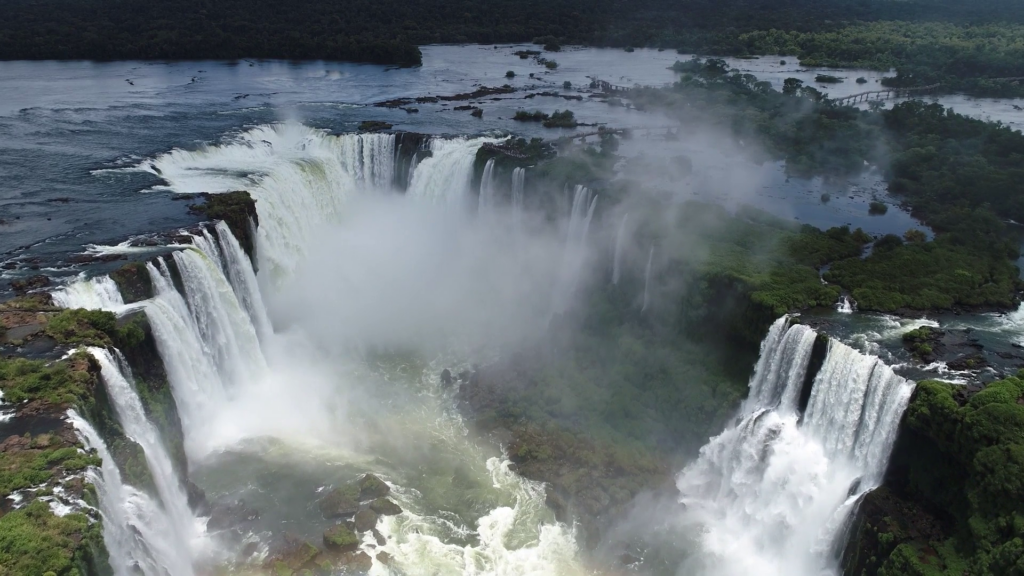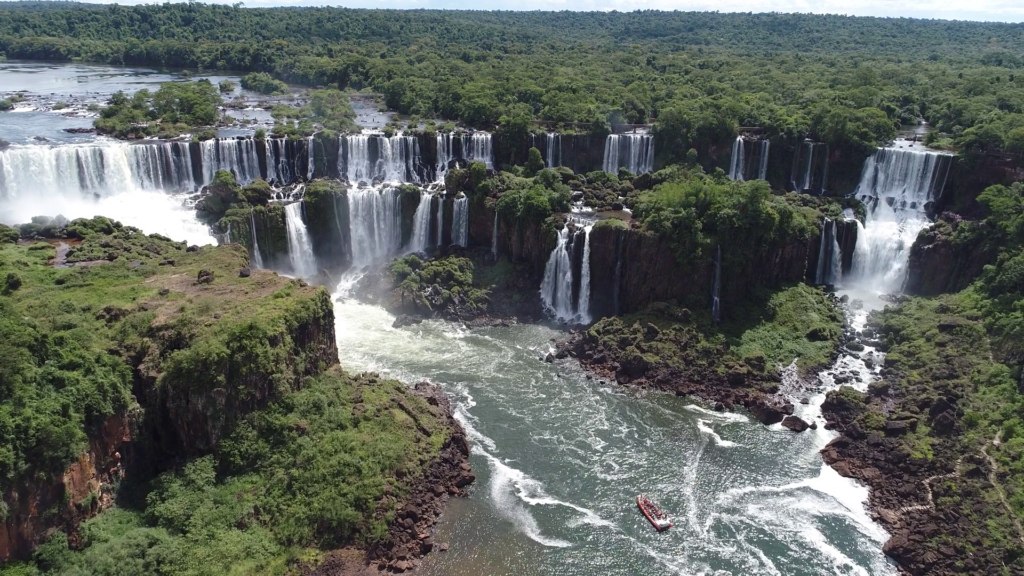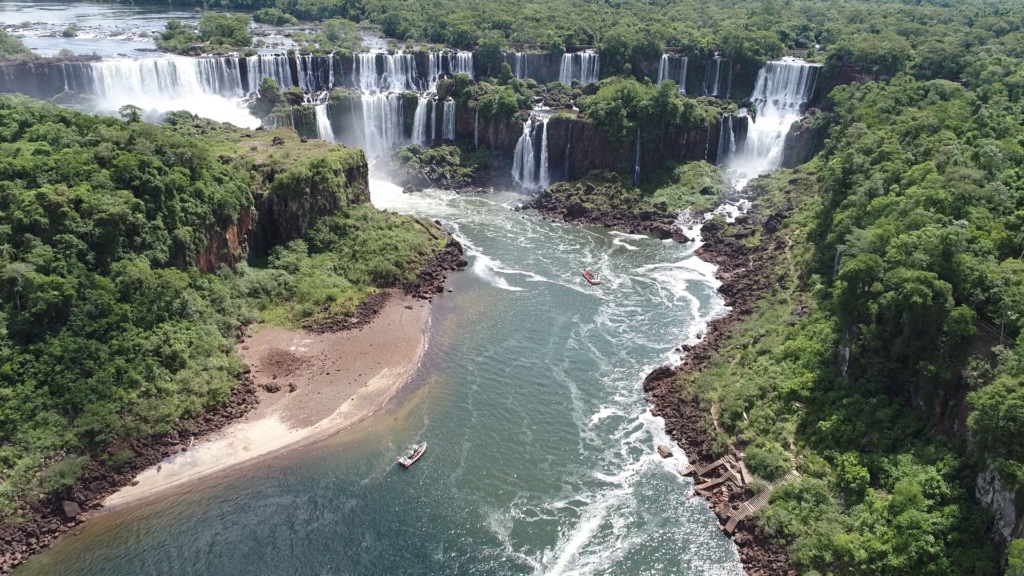Situated at the confluence of Brazil, Argentina, and Paraguay, Iguazu Falls is a spectacle of nature’s artistry and power. This breathtaking collection of waterfalls has captivated the hearts of explorers and nature lovers alike, offering a profound sensory and emotional experience that reverberates through the soul of every visitor.
The Spellbinding Vision of Iguazu Falls
Upon approaching Iguazu Falls, one is enveloped by the overwhelming sound and sight of water cascading across a vast network of falls. With approximately 275 drops stretching over nearly 3 kilometers, the falls create an endless panorama of rushing water, mist, and rainbows. The largest of these, known as the Devil’s Throat, is a U-shaped chasm that intensifies the spectacle with its thunderous roar and stunning 80-meter drop.
The surrounding rainforest adds to the allure, enhancing the falls with lush greenery that hosts a diverse array of wildlife. This natural setting forms an exquisite backdrop, painting every view with vibrant colors and dynamic textures, thus making the falls not only a powerful natural wonder but also a picturesque masterpiece.

A Gateway to Discovery
Delving into the heart of Iguazu Falls is an adventure that ignites curiosity and wonder. The area is accessible through a series of walkways and trails that allow for varied perspectives and experiences. Each path offers its own unique sights and sounds, providing intimate glimpses into the complex ecosystem that thrives at the falls.
Visitors can embark on boat trips that bring them near the base of the thundering waters, a place where the immense force and beauty of the falls can be truly appreciated. The spray of the water and the rhythmic sound of the falls create an immersive experience that is both exhilarating and meditative.

The Ecological Tapestry of Iguazu Falls
The environment around Iguazu Falls is as compelling as the falls themselves. The region is part of a larger protected area that spans both Brazil and Argentina, safeguarding numerous species of flora and fauna. This biodiversity is crucial, not only for the health of the ecosystem but also for the research and conservation efforts that continue to uncover the complexities of the tropical rainforest.
Bird enthusiasts will find the Iguazu National Park particularly enchanting, as it is home to rare species such as the colorful toucan and the elusive jaguar. The rich biodiversity ensures that every visit is filled with discoveries and opportunities to connect with nature on a profound level.

Cultural and Historical Resonance
Iguazu Falls is steeped in history and culture, with its significance stretching beyond natural beauty. The name ‘Iguazu’ originates from the Guarani or Tupi words ‘y’ (water) and ‘ûasú’ (big), underscoring the indigenous roots of the region. The falls have been a site of reverence and admiration for centuries, featured in local mythology and revered as a place of extraordinary power and beauty.
Today, the cultural impact of Iguazu Falls continues as it attracts visitors from around the globe, promoting cross-cultural exchange and appreciation for the natural world. The falls symbolize not only geographical and ecological wonders but also a bridge between cultures and generations.

The Seasons of Iguazu Falls
The experience of visiting Iguazu Falls varies with the seasons, each offering a distinct flavor and spectacle. The rainy season, spanning from December to March, sees the falls at their most formidable, with water levels at their peak. This period brings a fierce and wild beauty to the falls, showcasing their power as the water roars through the rainforest.
Conversely, the dry season, which runs from April to November, provides a more subdued but equally fascinating view. The reduced flow allows visitors to see the intricate rock formations and islands that are submerged during high water periods, presenting a different aspect of Iguazu Falls’ beauty. The lower water levels also make certain trails and viewpoints more accessible, offering a closer examination of the natural intricacies of this majestic site.

Frequently Asked Questions
What is the best time to visit Iguazu Falls?
The ideal visit time depends on personal preferences for scenery and activities. The rainy season offers dramatic views with voluminous water flow, while the dry season allows for more extensive exploration of the area.
How accessible is Iguazu Falls?
Both the Brazilian and Argentine sides of the falls are equipped with well-maintained walkways and viewing platforms. Accessibility options for those with mobility challenges are available, including wheelchair-accessible paths and elevators in some areas.
What should I bring to Iguazu Falls?
Prepare for a humid and wet climate. Waterproof clothing, protective gear for electronic devices, and comfortable walking shoes are recommended. Also, don’t forget to bring insect repellent and sunscreen.
Are there guided tours available at Iguazu Falls?
Yes, guided tours are available and can provide insightful commentary and deeper understanding of the ecological and historical significance of the falls.
Can I visit both the Brazilian and Argentine sides of the falls?
Yes, it’s possible and recommended to explore both sides, as they offer different perspectives and experiences. Ensure to check visa requirements if you are an international traveler.

Conclusion
Iguazu Falls stands as one of the most spectacular natural wonders of the world, captivating all who visit with its immense power and stunning beauty. The falls serve as a reminder of the majesty of our natural world and the importance of preserving such treasures for future generations. Each visit to Iguazu Falls offers a unique encounter with nature, filled with awe-inspiring moments and a deep, resonant connection to the earth.

Recommendations for Tourists
Planning a trip to Iguazu Falls is an exciting prospect and to ensure an enriching experience, consider these tips:
Plan ahead for the weather: Check the forecast and choose your visit based on the experience you desire, be it the full force of the rainy season or the detailed exploration possible in the dry season.
Respect the natural environment: Stay on designated paths, do not litter, and avoid feeding or disturbing the wildlife.
Consider the full experience: Allocate enough time to visit both the Brazilian and Argentine sides of the falls to fully appreciate their grandeur.
Stay hydrated and protected: The climate can be deceptively sunny and humid. Drink plenty of water and protect yourself from sun exposure.
Capture memories safely: While photography is a must, always prioritize safety over the perfect shot, especially near slippery or wet areas.
By adhering to these recommendations, your visit to Iguazu Falls will not only be memorable but also comfortable and respectful towards this magnificent natural wonder.